Nestled within the dramatic limestone mountains of northern Vietnam, Bac Sum Pass marks the thrilling beginning of the legendary Ha Giang Loop. This winding mountain passage not only challenges drivers with its serpentine curves but also rewards them with spectacular panoramic vistas that capture the essence of Vietnam’s most breathtaking frontier. As the symbolic gateway to Ha Giang’s treasures, Bac Sum Pass combines natural beauty, cultural significance, and historical importance into an unforgettable introduction to Vietnam’s final frontier.
1. Why Visit Bac Sum Pass?
Bac Sum Pass serves as both a literal and symbolic gateway to the wonders of Ha Giang Province. Situated approximately 30km from Ha Giang City along National Road 4C, this dramatic mountain pass marks the true beginning of the famous Ha Giang Loop. The moment your vehicle begins climbing its slopes, you’ll understand why this pass holds such significance.
The breathtaking scenery alone justifies a visit, with towering limestone karsts creating a dramatic backdrop against winding roads. As you navigate the hairpin turns, each bend reveals another postcard-worthy vista of lush valleys and distant mountain silhouettes. These views provide excellent opportunities to capture the raw, untamed beauty of Vietnam’s northern frontier.
Beyond aesthetics, Bac Sum Pass carries historical significance dating back to Vietnam’s colonial era and wartime periods. The road itself represents an engineering achievement, carved through challenging mountain terrain to connect previously isolated highland communities. For adventure seekers, the pass offers that perfect combination of exhilaration and beauty that defines the best mountain journeys.
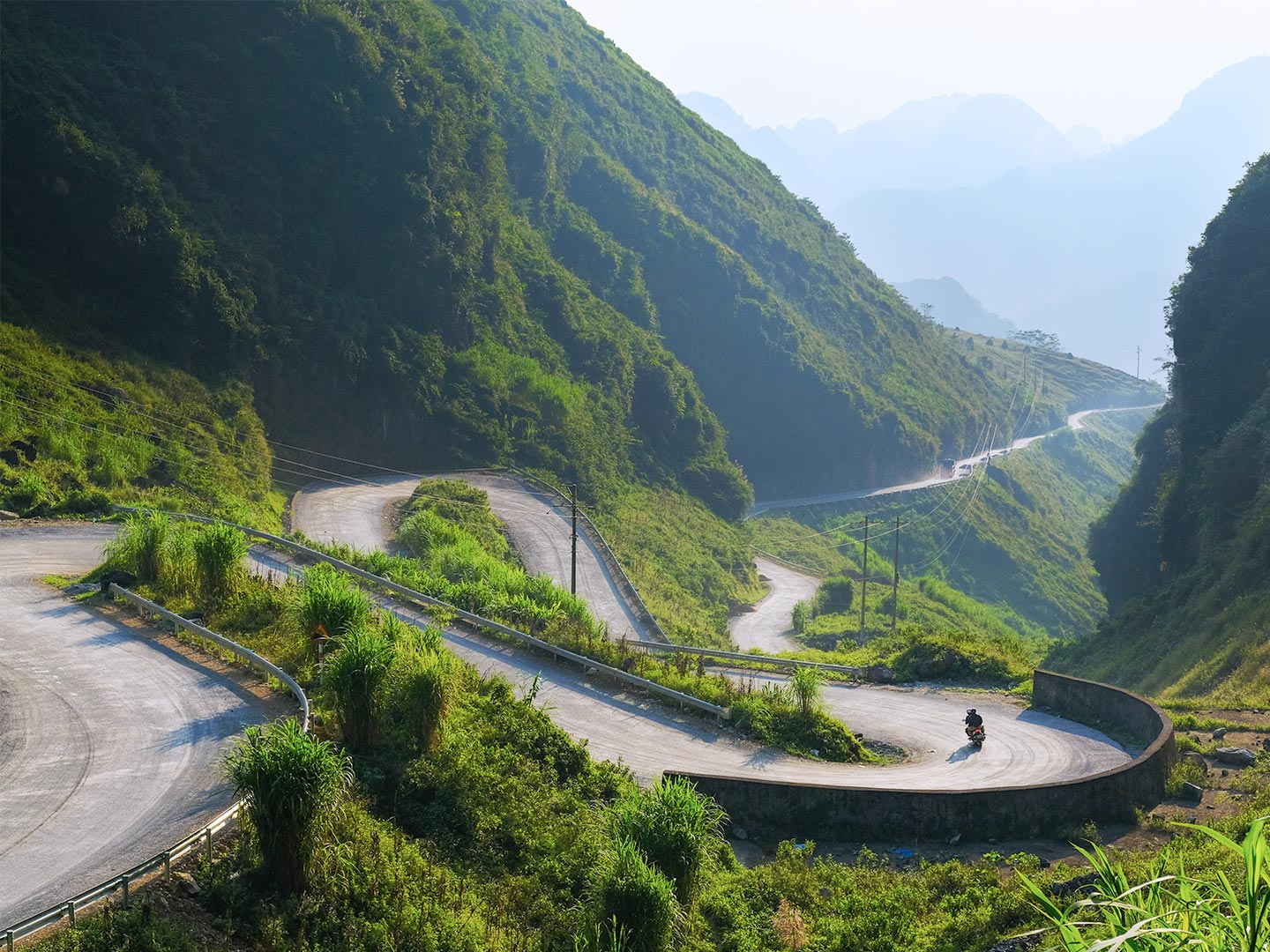
2. Getting There
The road to Bac Sum is part of the adventure itself. From Hanoi to Ha Giang, every stretch brings new landscapes, new emotions, and a growing sense of anticipation as the mountains draw near.
2.1 Directions from Hanoi/Ha Giang City
The journey to Bac Sum Pass typically begins in Hanoi, approximately 300km south. Most travelers first make their way to Ha Giang City, then continue northward along National Road 4C toward Quan Ba District. From Ha Giang City’s center (marked by the KM0 milestone), Bac Sum Pass lies about 30km away, making it the first major mountain pass you’ll encounter on the Ha Giang Loop.
Signs for Bac Sum Pass (Đèo Bắc Sum) are clearly visible along Highway 4C as you leave Ha Giang City. The pass officially begins near Vi Xuyen District, with the road gradually climbing through increasingly dramatic mountain terrain. Most tourists reach the pass within 45-60 minutes of leaving Ha Giang City, depending on traffic and weather conditions.
For those using navigation apps, simply set “Bac Sum Pass” or “Đèo Bắc Sum” as your destination. The route is straightforward, following the main Highway 4C, which eventually connects to other highlights like Heaven’s Gate and Quan Ba Twin Mountains.
2.2 Transportation Options
The most popular way to experience Bac Sum Pass is by motorbike, offering the freedom to stop at numerous viewpoints along the route. In Ha Giang City, various rental services provide motorbikes ranging from automatic scooters to more powerful semi-automatic and manual bikes. Prices typically range from 150,000 to 500,000 VND per day, depending on the model and rental period.
For those uncomfortable with riding motorbikes, hiring a car with a local driver provides a safer alternative. These services cost more (approximately 800,000-1,200,000 VND per day) but include an experienced driver familiar with the challenging mountain roads. Many hotels and tour agencies in Ha Giang City can arrange these services with advance notice.
If you’re arriving from Hanoi, sleeper buses offer the most convenient connection to Ha Giang City. These buses typically depart in the evening, arriving early the next morning. Upon reaching Ha Giang, you can then arrange transportation to Bac Sum Pass and beyond. For travelers seeking convenience and peace of mind, Phieu Travel offers comprehensive packages that include transportation arrangements from Hanoi to Ha Giang and guided tours of the entire loop.
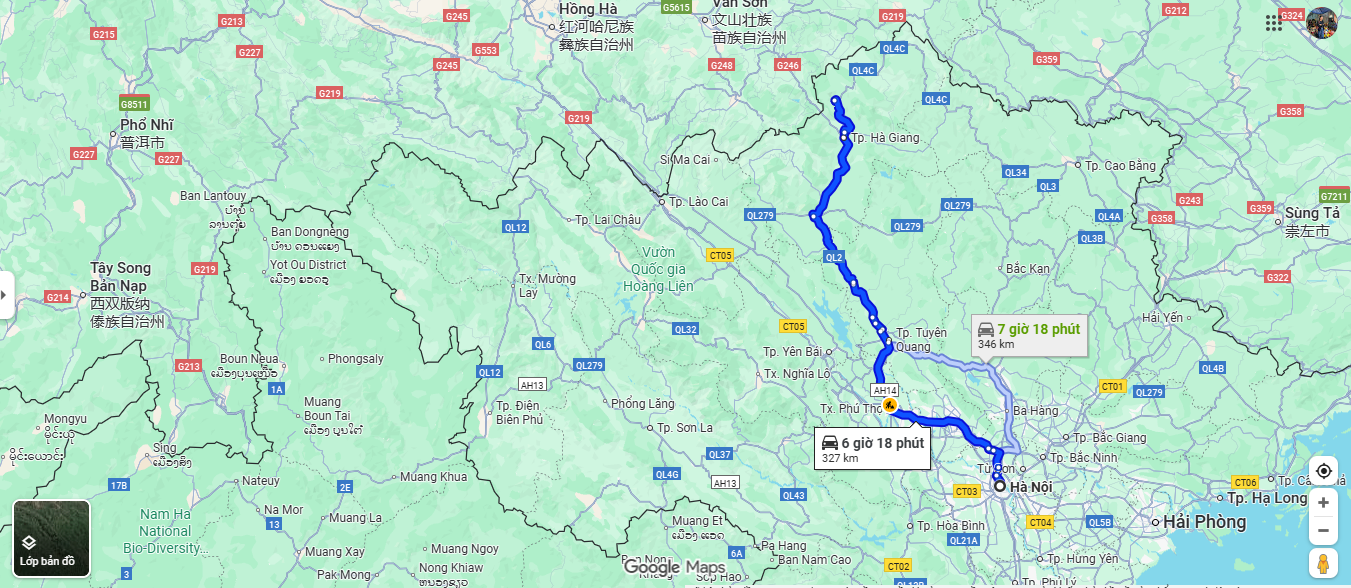
The Ultimate Guide to Driving the Ha Giang Loop by Car from Hanoi
3. Must-Stop Highlights of Bac Sum Pass
Bac Sum isn’t just a road it’s a collection of quiet, unforgettable pauses. Each stop offers a new perspective, a moment to breathe deeply, and to let the mountain air fill your soul.
3.1 Minh Tan Stream
Nestled at the foot of Bac Sum Pass, Minh Tan Stream offers a refreshing respite from the road. This crystal-clear mountain stream winds through lush vegetation, creating a serene environment perfect for relaxation. The sound of water flowing over smooth stones creates a natural soundtrack that instantly soothes travel fatigue.
Visitors particularly enjoy the short walking paths alongside the stream, which showcase the area’s biodiversity. Depending on the season, wildflowers bloom along the banks while butterflies and dragonflies hover above the water. The stream’s clear waters often reveal small fish darting between rocks, adding to the location’s natural charm.
For photography enthusiasts, early morning visits provide the best lighting conditions when sunlight filters through the trees and morning mist hovers above the water. Several natural pools along the stream are ideal for capturing reflections of the surrounding mountains. After exploring, several small vendors near the stream entrance offer local tea and snacks, allowing you to rest while absorbing the peaceful atmosphere.
3.2 Bac Sum Pass Viewpoint
The official Bac Sum Pass Viewpoint sits at one of the highest points along the pass, offering a 180-degree panorama that captures the essence of Ha Giang’s landscape. This purpose-built observation area features stone barriers and plenty of space for parking, making it accessible for both independent travelers and tour groups.
From this vantage point, visitors can witness the dramatic interplay of elements that make Ha Giang unique. Limestone mountains rise dramatically from emerald valleys, while terraced fields carve geometric patterns into the hillsides. The ribbon-like road you’ve just traveled snakes visibly through the landscape, highlighting the engineering marvel of the pass itself.
The viewpoint experiences ever-changing lighting conditions throughout the day. Morning hours often bring misty conditions with mountains playing hide-and-seek behind low clouds. By midday, visibility typically improves with sharper contrasts between mountains and valleys. Late afternoon visits reward photographers with warm, golden light casting long shadows across the dramatic terrain a perfect backdrop for silhouette shots against the setting sun.
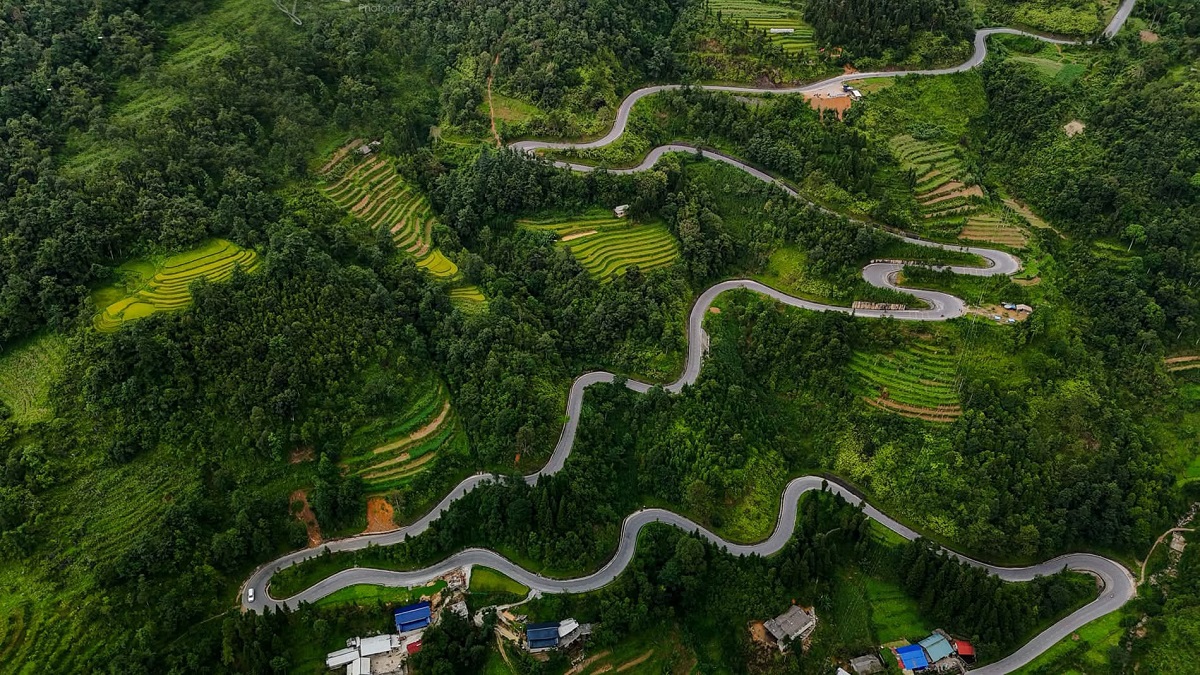
3.3 Tham Luong Cave
Hidden among the limestone formations of Bac Sum Pass, Tham Luong Cave offers an intriguing glimpse into the region’s geological history. The cave entrance, framed by stalactites, leads into a cool underground world that provides welcome relief from summer heat. Inside, nature has sculpted an impressive gallery of stone formations over millions of years.
Local legends add cultural significance to this natural wonder. According to stories passed through generations, the cave once served as a hideout for resistance fighters during conflicts with neighboring countries. Other tales speak of supernatural guardians who protect treasures hidden deep within the cave system. These stories reflect the strong connection between local ethnic groups and their natural environment.
Exploring Tham Luong requires basic precautions. The cave floor can be slippery, so wearing sturdy footwear with good traction is essential. Bringing a flashlight enhances the experience, revealing intricate details of stalactites and stalagmites not visible in ambient light. Some deeper sections remain unexplored, preserving the cave’s mysterious allure for more adventurous visitors.

3.4 Hoa Tam Buckwheat Flower Fields
During autumn months (October to November), the hillsides near Bac Sum Pass transform into a sea of pink and purple when buckwheat flowers bloom. These Hoa Tam Buckwheat Flower Fields create one of Vietnam’s most enchanting seasonal landscapes, drawing photographers and nature lovers from across the country and beyond.
Buckwheat holds both agricultural and cultural significance for local ethnic minorities. The hardy plant thrives in the challenging mountain environment, providing food and economic opportunities for highland communities. After harvesting, farmers use the grains to make traditional dishes like buckwheat cakes and noodles. These foods feature prominently during festivals and special occasions, representing the resilience of mountain communities.
For the best viewing experience, plan your visit in late October when the flowers reach peak bloom. Early morning light bathes the fields in a soft glow, creating ideal conditions for photography. Local guides can direct you to less-visited fields away from popular viewing spots, allowing for more peaceful appreciation of this natural phenomenon. Some families open their homes during flowering season, offering traditional meals featuring buckwheat products.
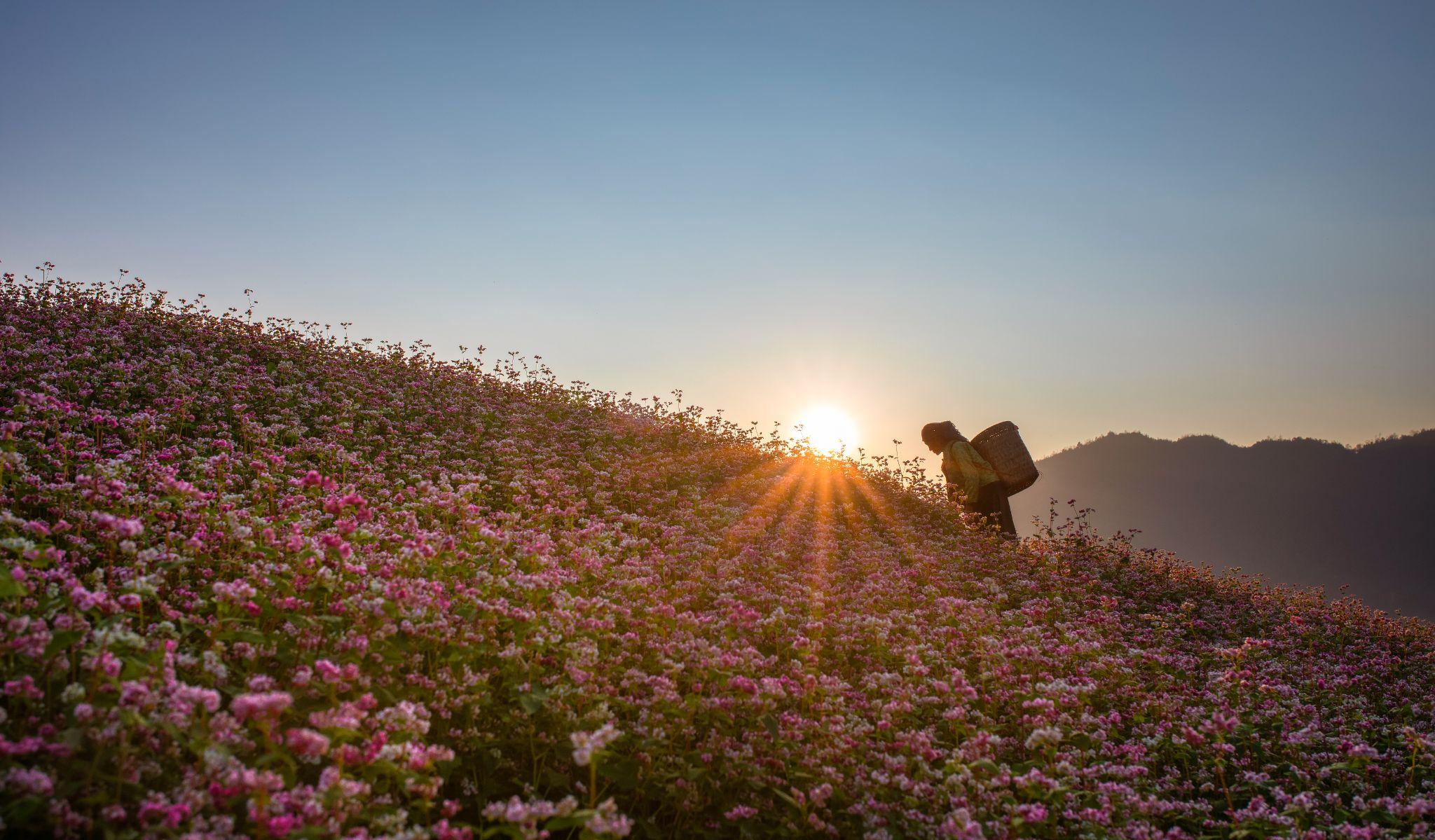
Ha Giang weather in October: climate, best time to visit & tips
3.5 Heaven’s Gate and Twin Mountains
While technically located beyond Bac Sum Pass, Heaven’s Gate and the Twin Mountains form a natural extension of the journey. After conquering Bac Sum, continuing approximately 20km brings you to Heaven’s Gate (Cổng Trời Quản Bạ), a magnificent viewpoint standing at 1,500 meters above sea level. The name comes from the feeling of standing in the clouds, with misty valleys stretching toward the horizon.
From Heaven’s Gate, visitors gain their first glimpse of the famous Twin Mountains (Núi Đôi Quản Bạ). These distinctive breast-shaped hills rise prominently from the valley floor, inspiring the local name “Núi Vú” or “Fairy Bosom.” According to Hmong legend, these mountains were formed when a mountain fairy left her bosom behind to nurture the land after falling in love with a local man.
A dedicated viewing platform at Heaven’s Gate provides the perfect vantage point for photographing this unique landscape. Mornings often feature a sea of clouds surrounding the Twin Mountains, creating an ethereal atmosphere that justifies the heavenly name. Small cafes near the viewing area serve traditional tea and coffee, allowing visitors to linger while absorbing one of Vietnam’s most mythical landscapes.
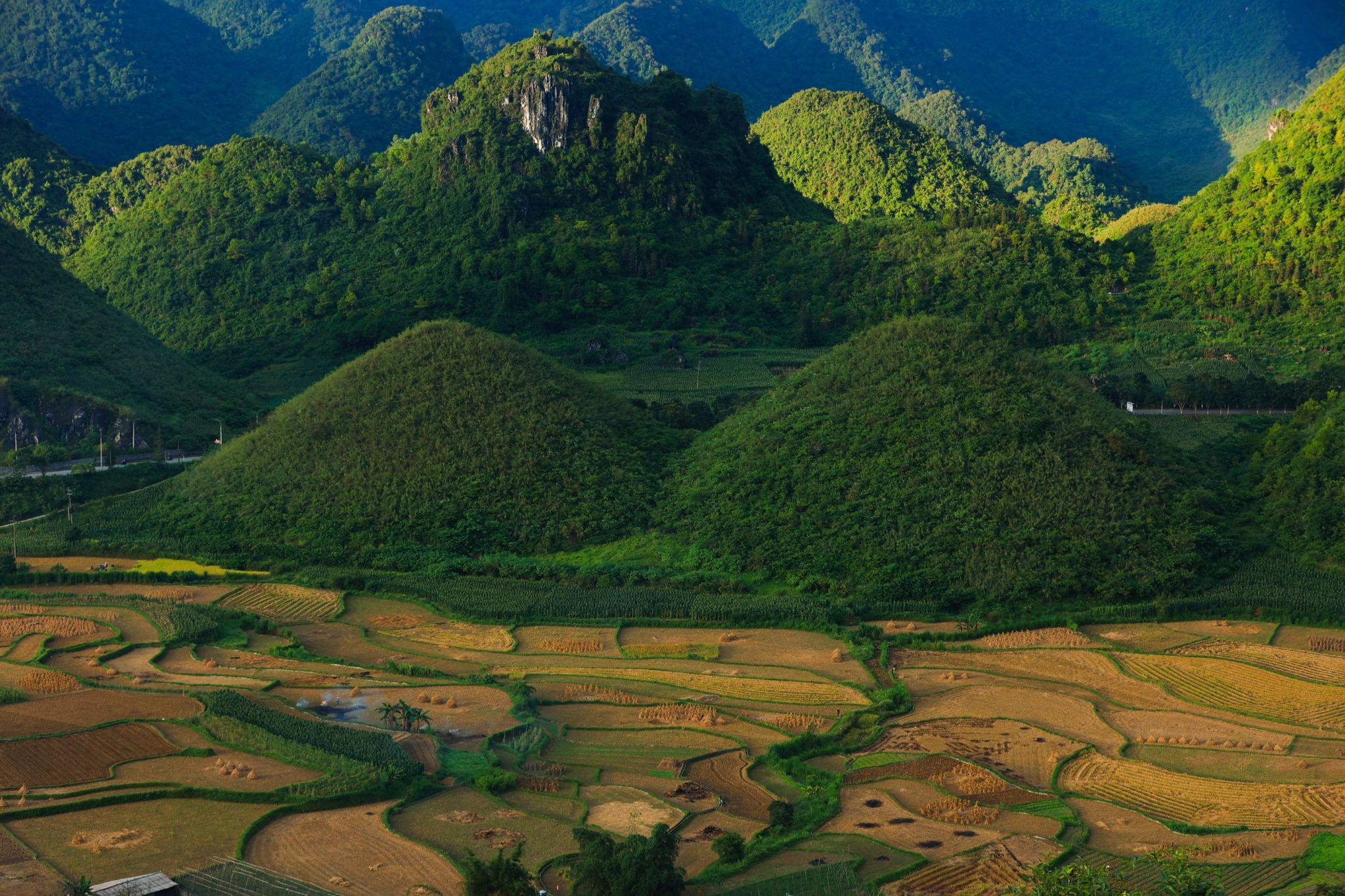
Quan Ba Heaven Gate Gateway to Ha Giang’s Mystical Highlands
4. History and Cultural Significance
Behind Bac Sum’s stunning scenery lies a story of endurance. These cliffs and winding paths once carried the footsteps of soldiers and villagers who stood guard over Vietnam’s northern frontier.
4.1 Role During Colonial Wars
Bac Sum Pass played a strategic role during Vietnam’s turbulent history, particularly during the colonial period and subsequent conflicts. The pass’s steep terrain and commanding heights provided natural defensive positions, making it a key location for controlling movement through Ha Giang Province. French colonial forces recognized this strategic value, establishing monitoring posts along the pass to maintain surveillance over the mountainous region.
During the resistance against French colonization, local ethnic minority communities used their intimate knowledge of Bac Sum’s rugged landscape to support Vietnamese independence fighters. Hidden paths and caves around the pass served as secret routes and shelters, enabling guerrilla tactics against better-equipped colonial forces. These stories of resistance remain an important part of the pass’s heritage, commemorated through local monuments and memorial sites.
The road itself represents an engineering accomplishment with historical significance. Initially constructed as a basic trail, it was gradually expanded during different periods of Vietnam’s history. The most significant improvements came during the 1960s when the broader “Happiness Road” project connected previously isolated northern communities to the rest of Vietnam. This infrastructure development fundamentally changed life in the highlands, opening remote areas to education, healthcare, and economic opportunities.
4.2 Impact on Local Communities
For the ethnic minority groups inhabiting the areas around Bac Sum Pass, the road’s development has brought profound changes to traditional ways of life. Communities that were once largely self-sufficient have gradually integrated into wider economic networks, selling agricultural products and handicrafts to passing travelers. This increased connectivity has created new income opportunities while posing challenges to cultural preservation.
The Hmong, Dao, and Tày peoples who live in villages near the pass maintain distinct cultural identities through language, traditional dress, and agricultural practices. Terraced fields visible from various viewpoints along Bac Sum Pass represent centuries of agricultural knowledge, perfectly adapted to the challenging mountain environment. These communities celebrate seasonal festivals tied to agricultural cycles, with spring festivals marking planting seasons and autumn celebrations honoring harvests.
Tourism has emerged as both opportunity and challenge for these communities. While visitor interest in authentic cultural experiences creates economic benefits, it also places pressure on traditional practices. Thoughtful tourism initiatives led by community members themselves help balance economic development with cultural preservation. When visiting, engaging with local guides from these communities provides deeper insight into their relationship with this dramatic landscape.
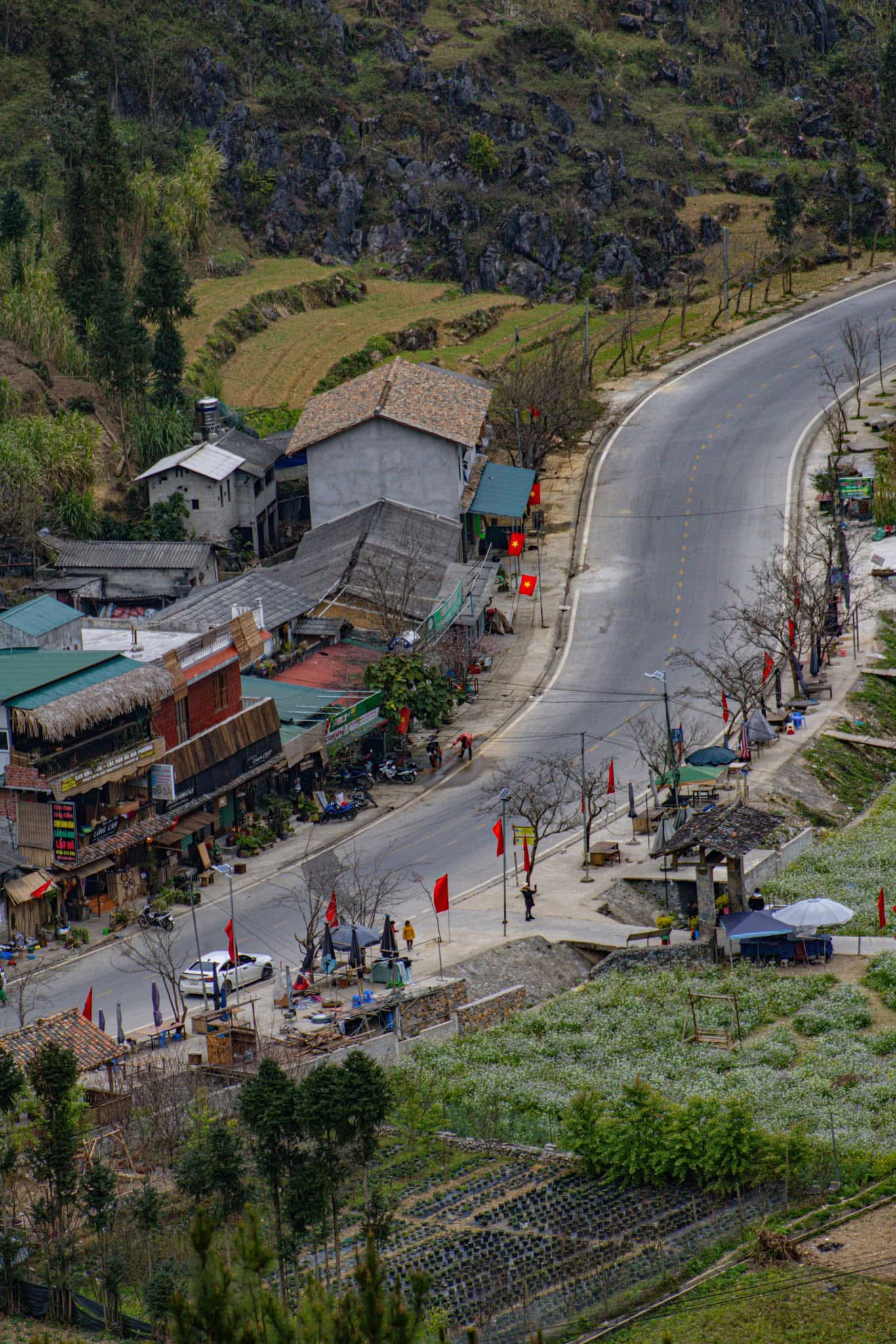
Beyond the Beaten Path: Discovering Ha Giang Province in Northeast Vietnam
5. Tips for a Safe and Memorable Visit
Every trip to Bac Sum is an adventure in itself. A bit of preparation and awareness will help you enjoy the road with confidence and let the mountain breeze wash away every trace of fatigue.
5.1 Best Travel Seasons
Timing your visit to Bac Sum Pass can significantly impact your experience. The most favorable period runs from September to November and March to May, when clear skies and moderate temperatures create ideal conditions for both driving and photography. During these months, rainfall is minimal, ensuring good road conditions and unobstructed mountain views.
October and November offer additional visual splendor when buckwheat flowers bloom across the highlands. This seasonal phenomenon transforms hillsides into carpets of pink and purple, creating one of northern Vietnam’s most photogenic landscapes. The autumn months also coincide with rice harvesting in many terraced fields, adding golden hues to the mountain scenery.
Winter months (December to February) bring crisp, cool air and excellent visibility on clear days, though early mornings and evenings can be quite cold with temperatures occasionally dropping below 10°C. Summer (June to August) offers lush green landscapes but comes with challenges including frequent rain showers and potential fog that can obscure views and make driving hazardous. If visiting during rainy seasons, build flexibility into your schedule to accommodate weather delays.
5.2 Safety Precautions on Mountain Roads
Bac Sum Pass demands respect from all travelers, especially those navigating its curves by motorbike. The road features numerous hairpin turns, steep sections, and occasional loose gravel, particularly after rain. Maintaining moderate speeds, using lower gears on steep descents, and anticipating oncoming traffic around blind curves are essential practices for safe passage.
For motorbike riders, proper safety equipment is non-negotiable. Always wear a quality helmet, preferably full-face for maximum protection. Long sleeves, pants, and closed shoes provide basic protection against minor falls and changing weather conditions. Carrying rain gear year-round is advisable, as mountain weather can change rapidly even during dry seasons.
Local driving customs require adaptation for international visitors. Vehicles often use horns when approaching blind corners not as aggression but as a safety signal. Larger vehicles generally expect smaller ones to yield on narrow sections. During foggy conditions, which can occur year-round but are most common in early mornings, reduce speed dramatically and use headlights even during daytime hours.
5.3 What to Pack
A well-planned packing strategy enhances comfort and safety when visiting Bac Sum Pass. Beyond the standard travel essentials, consider these specific items for mountain environments:
- Layered clothing: Mountain temperatures fluctuate dramatically between day and night. Lightweight, quick-drying layers allow adaptation to changing conditions.
- Sun protection: The mountain sun can be surprisingly intense at higher elevations. Sunglasses, hat, and sunscreen protect against UV exposure.
- Camera equipment: For photography enthusiasts, a polarizing filter reduces glare and enhances colors, particularly useful for landscape shots. A small tripod enables stable long-exposure shots of waterfalls and evening scenes.
- First aid basics: Include band-aids, antiseptic wipes, pain relievers, and any personal medications. Medical facilities are limited in remote areas.
- Power bank: Limited charging opportunities along the route make portable power essential for keeping devices operational, particularly important for navigation and emergency communication.
- Cash: Few businesses around Bac Sum Pass accept cards, and ATMs are scarce beyond Ha Giang City. Carry sufficient Vietnamese dong for food, accommodation, and unexpected expenses.
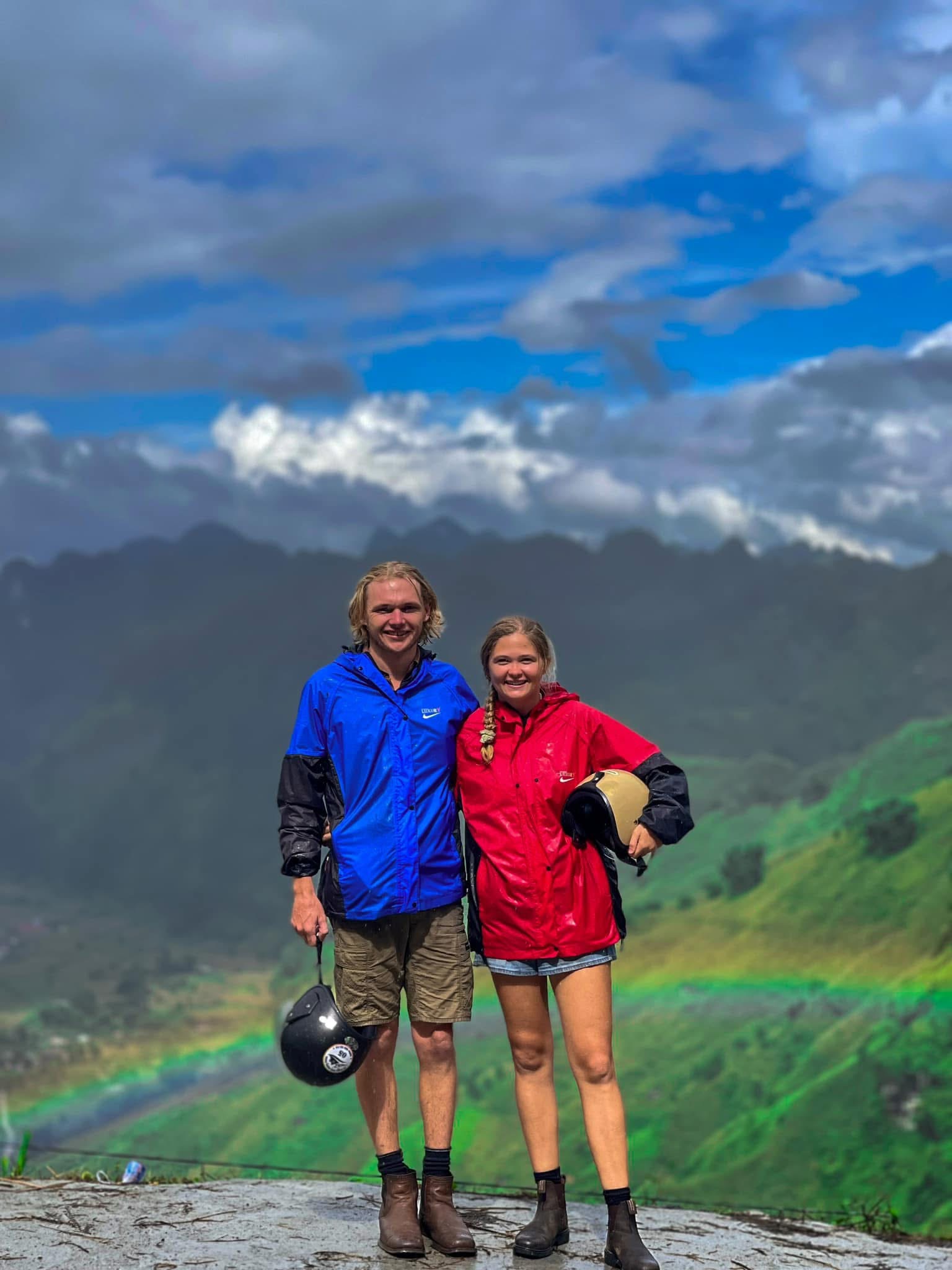
What to Pack for the Ha Giang Loop (Ultimate Packing Guide 2025)
6. Essential Local Experiences
Don’t just pass through Bac Sum stop for a cup of coffee above the clouds, listen to stories from the locals, or taste smoked pork and corn wine. These small moments are the true soul of Ha Giang.
6.1 Café/Rest Stop Highlights
Along Bac Sum Pass, several distinctive rest stops have emerged as destinations in their own right. “Cloud Café” sits near one of the highest points, offering spectacular views alongside Vietnamese coffee and tea. The open-air seating area features rustic wooden furniture positioned to maximize the panoramic vistas, creating a perfect environment for contemplating the landscape’s majesty.
These cafés offer more than refreshments they’ve evolved into cultural spaces where travelers and locals share stories and information. Walls often display maps of the region with handwritten notes from previous visitors highlighting hidden gems and advice. The relaxed atmosphere encourages connections between international travelers, fostering a community spirit among those exploring Ha Giang’s remote beauty.
Several stops also feature traditional costume rental services, allowing visitors to photograph themselves in elaborate Hmong or Dao attire against dramatic backdrops. While primarily aimed at tourists, these services often support local artisans who create and maintain the intricate costumes. These experiences, when approached respectfully, provide insight into the distinctive textile traditions that distinguish different ethnic groups across the highlands.
6.2 Local Cuisine to Try
Culinary experiences around Bac Sum Pass reflect the cultural diversity and agricultural traditions of Ha Giang Province. “Thắng cố,” a hearty stew traditionally made with horse meat but often prepared with beef or pork for tourists, exemplifies Hmong cuisine. The rich, aromatic broth contains various herbs gathered from surrounding mountains, creating a distinctive flavor profile found nowhere else in Vietnam.
At roadside eateries along the pass, smoked meats feature prominently on local menus. “Thịt hun khói” (smoke-cured pork) delivers intense flavor developed through traditional preservation methods. The meat hangs above cooking fires in mountain homes, gradually absorbing smoke from indigenous woods. Served with sticky rice and fresh vegetables, these preserved meats sustained highland communities through harsh winters before modern food storage.
No mountain journey is complete without sampling local rice wine (rượu). Around Bac Sum Pass, ethnic minorities produce distinctive varieties, often infused with medicinal herbs or wild fruits. Some establishments offer “rượu ngô” (corn wine) served in communal fashion from large ceramic jars using bamboo straws. While potent, these traditional spirits connect visitors to centuries-old celebratory customs that remain central to highland social life.
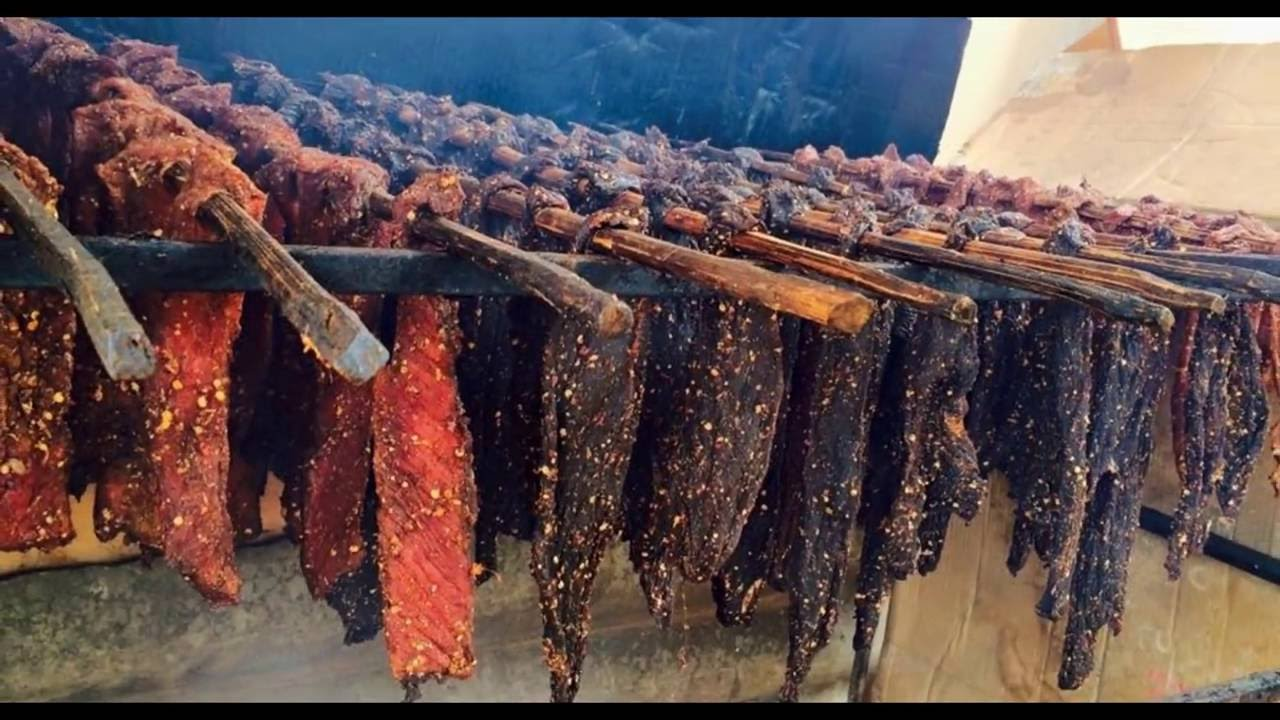
7. Nearby Attractions
The road doesn’t end at Bac Sum. Continue onward to Quan Ba, Yen Minh, and Dong Van each a unique chapter in Ha Giang’s magnificent landscape.
7.1 Connection to Dong Van Karst Plateau Geopark
Bac Sum Pass serves as the gateway to one of Vietnam’s geological wonders the Dong Van Karst Plateau Geopark. Recognized by UNESCO in 2010, this geopark covers 2,356 square kilometers of spectacular limestone formations, representing over 400 million years of Earth’s history. The dramatic landscapes visible from Bac Sum Pass offer just a preview of the extraordinary terrain that unfolds further along the Ha Giang Loop.
The geopark’s significance extends beyond aesthetics it contains rich paleontological and geological evidence of the region’s formation. Fossilized marine creatures found in rock formations tell stories of ancient oceans that once covered the area. These scientific treasures, combined with the human history of adaptation to this challenging environment, create a destination of outstanding universal value that draws researchers and enthusiasts from around the world.
For travelers continuing beyond Bac Sum Pass, the geopark offers numerous specialized attractions including the Quan Ba Fairy Mountains, Lung Cu Flag Tower marking Vietnam’s northernmost point, and Ma Pi Leng Pass considered Vietnam’s most spectacular mountain road. Each site provides a different perspective on the karst landscape’s diverse features, from sheer cliffs and deep valleys to hidden caves and underground rivers that shape this unique ecosystem.
7.2 Other Points of Interest on the Ha Giang Loop
The full Ha Giang Loop extends approximately 350 kilometers, forming a circular route through the province’s most breathtaking scenery. After Bac Sum Pass and Heaven’s Gate, Yen Minh district offers pine forests reminiscent of European alpine landscapes. The district’s valley, surrounded by limestone mountains, creates a distinct microclimate supporting diverse agricultural activities visible in the patchwork fields below viewpoints.
Dong Van Ancient Town preserves architecture from the early 20th century, with stone houses featuring Chinese-influenced details reflecting the area’s border heritage. The Sunday market draws ethnic minorities from surrounding villages, creating a vibrant display of traditional costumes and local products. Nearby, the Hmong King’s Palace tells stories of regional politics during French colonial times through its unique blend of European and local architectural elements.
No Ha Giang journey is complete without experiencing Ma Pi Leng Pass and the emerald waters of Nho Que River below. Often described as Vietnam’s most spectacular road, Ma Pi Leng’s sheer cliffs and breathtaking viewpoints represent the culmination of the scenic crescendo that begins at Bac Sum Pass. Travelers can descend to the river for boat trips through towering canyons, offering yet another perspective on this remarkable landscape.
Bac Sum Pass stands as both physical gateway and symbolic threshold to one of Vietnam’s most extraordinary landscapes. Its winding roads, dramatic viewpoints, and cultural significance create a memorable introduction to the wonders that await along the full Ha Giang Loop. From misty morning vistas to encounters with ethnic minority cultures, the pass offers diverse experiences that reward travelers who approach with respect for both natural beauty and local traditions.
For travelers seeking to explore Bac Sum Pass and the broader Ha Giang region, Phieu Travel provides specialized itineraries that balance must-see highlights with authentic cultural experiences. Their local guides share insider knowledge about optimal viewpoints, seasonal attractions, and cultural context that deepens appreciation of this remarkable landscape. Whether you’re planning a short visit or comprehensive exploration of northern Vietnam’s highlands, discover more resources and tour options at Phieutravel.com to ensure your journey through Bac Sum Pass becomes a highlight of your Vietnamese adventure.
Read more:
- What to Pack for the Ha Giang Loop (Ultimate Packing Guide 2025)
- Explore Lao Xa Village: Hmong Life on Dong Van Plateau
- The Death Rock of Ha Giang A Challenge for Adventure Seekers

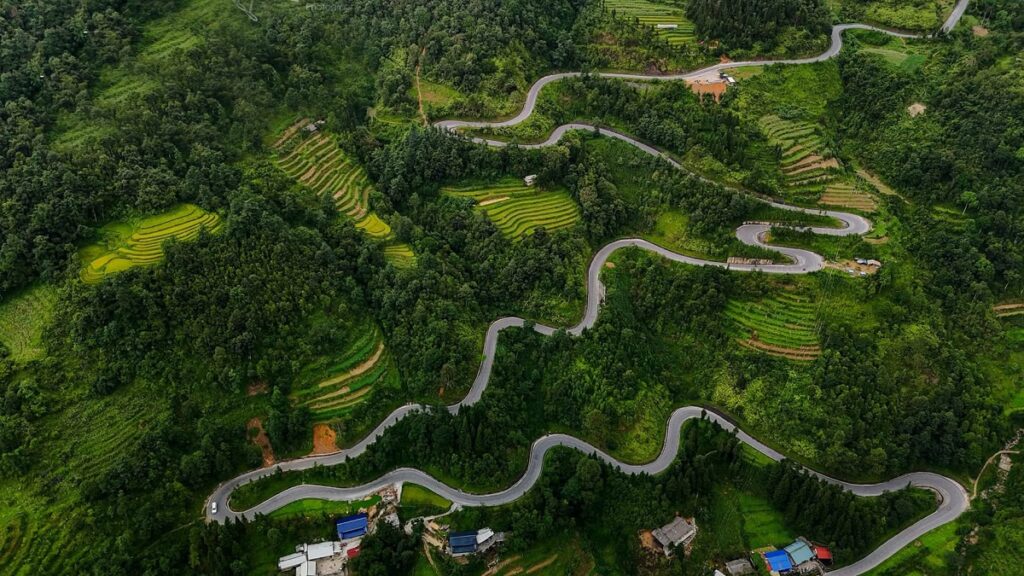
You Might Also Like
Ha Giang Weather in September: Complete Guide for Travelers
Exploring the magnificent Ha Giang Loop in September offers travelers a perfect balance of favorable[...]
Quan Ba Twin Mountains: Ha Giang’s Iconic Fairy Hills and Complete Travel Guide
The mystical Quan Ba Twin Mountains rise from the emerald valleys of Ha Giang like[...]
Vuong family mansion: the architectural marvel and cultural legacy of Ha Giang
Deep in Vietnam’s northern highlands, where mist-shrouded mountains meet terraced rice fields, stands a testament[...]
Ha Giang Loop Safety Tips: How to Ride Securely in Vietnam’s Northern Mountains
The Ha Giang Loop, with its winding mountain roads and breathtaking landscapes, offers one of[...]
The Ultimate Guide to the M-Shaped Curve on Ha Giang Loop
Vietnam’s remote northern province of Ha Giang hides a natural wonder that has captivated adventurous[...]
Most Beautiful Places to Visit in Vietnam: Essential Destinations and Insider Tips
Vietnam captivates travelers with its stunning landscapes, rich cultural heritage, and warm hospitality. From mist-shrouded[...]
Beyond the Beaten Path: Discovering Ha Giang Province in Northeast Vietnam
Ha Giang Province in Northeast Vietnam stands as one of the country’s last frontiers for[...]
Rainy season in Ha Giang: what to expect, when to go, and travel tips
Vietnam’s northern frontier reveals a different face during the rainy season, transforming Ha Giang’s limestone[...]